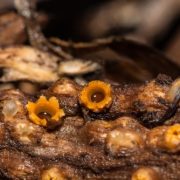MULCH ADO ABOUT NOTHING
(Yes, you read that correctly.) Translation: A lot of trouble or complaining about a small problem. In this case, a mulch problem…
“Keeping up with the Jones’.” It’s a thing. Another cliche: “Imitation is the greatest form of flattery.” But what if status quo is only perpetuating misinformation? A freshly mulched garden looks lovely and well-groomed, but within lies a deceptive fungal plot ready to hatch and wreak havoc on your home.
Mulch by definition is material such as decaying leaves, bark, or compost, spread around or over a plant to enrich or insulate the soil. Mulching does have many benefits to your plantings and your soil. Besides the obvious intimation of landscape aesthetic, it also serves to regulate and protect soil temperature and moisture. It promotes water conservation and weed prevention, enhances soil nutrients, and helps to remove residual effects of pesticides, fertilizers, and heavy metals. A thin layer of 1-2″ is sufficient. Types of mulch include Wood, Rock, and Synthetic. Look for naturally sourced wood mulch NOT commercial or construction debris-based, which will contain contaminants.
Mulching is nearly a science of its own. While it is simplistic, it involves a complicated ecosystem. The trouble with mulch lies in over-mulching, which nearly everyone does. In excess, it deprives oxygen from plant roots, causing plants to re-root in mulch, then die out when the mulch dries out. Large, bark/wood chip mulch deprives soil of Nitrogen and takes longer to decompose, at least a year. Mulch piled against tree trunks actually promotes bark decay. Instead, follow the rule of the ‘Casey Trees’ Organization, the “Three-Three-Three” Method: “A 3′ diameter mulch circle around a tree, 3″ thick, 3″ AWAY from the trunk.”
Laying mulch too thickly smothers roots of trees and shrubs in search of air and water. Excessive hardwood mulch can become toxic to plants due to buildup of elements. Avoid mounding at shrubs, especially azaleas and boxwood, as their surface roots will grow into mulch, eventually starving the plants as mulch decays. Perennials smothered in mulch will rot when their natural cycle of dormancy is too wet.
Roger Davis, Senior Gardener at Longwood Gardens, recommends two types of Mulch: “Triple-shredded hardwood bark” and “Leaf Mold”, (tree leaves on their way to becoming compost). *(See Recipe at end of article.)
MUCH ADO ABOUT MULCHING
The University of Delaware explains: “Mulch provides a food source for fungi that are natural decomposers, breaking down plant material and utilizing organic matter. Without fungi, dead leaves, twigs, and branches would clutter forests and landscapes.” While a necessary decomposer, unfortunately this means your mulch pile is also a breeding ground for various home offenders such as: slime molds, stinkhorns, bird’s nest fungi, and artillery fungus.
At first glance, these seem only a negligible nuisance. However, left undisturbed, mold and fungus can wreak havoc on your home. Black stripes on your roof, green slime on your siding and flatwork, or miniscule black spots that appear on your siding are the result of a humid, fertile, breeding ground that has been fed by mulch.
Artillery fungi, the most pervasive of these offenders, is so tenacious that complete removal is nearly impossible. Naturally occurring in mulch, not only will it transfer onto your home, but also your plantings. Without proper removal from your home and mulch, you are sure to have a repeat offender. If caught immediately, these spores may be scrubbed away with a brush and soap and water. However, if the material has dried, it must be scraped off, being careful not to re-litter the soil or mulch, which will, of course, mean re-infestation. Even with successful removal, these tarry spores leave their mark and will stain siding. Worse still, replacement of siding is the only solution to complete removal, and that is completely out of your pocket.
One solution to combating the prevalence of artillery fungus is incorporating mushroom compost (or mushroom soil) into the mulch. Mixing in 20-40% mushroom compost into your mulch is sufficient to reduce growth of artillery fungus. Doing so is both economic and proactive for your garden, the planet, and your budget.
THE LESSON: Don’t placate your garden with good intentions. Do your research to find the right solution for your plantings, not to fit in your neighbourhood. Be deliberate, not deceived. And when it comes to removal of mold and fungus, no one FIGHTS GRIME like we do.
How to Make Your Own “Leaf Mold”: (According to Washington Post)
- Gather the fallen leaves from Autumn.
- Shred with your mower.
- Put into compost pile or store in plastic bag.
- Use next Spring as Mulch. OR
- Spread chopped leaves directly onto beds in Autumn.
- Let Nature take its course. Soil creatures convert leaves into humus.
- Better for the planet. Better for your pocket.



